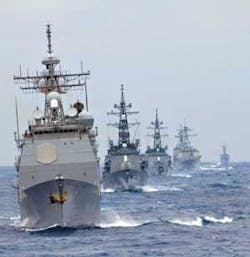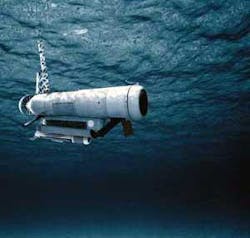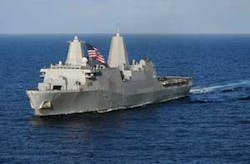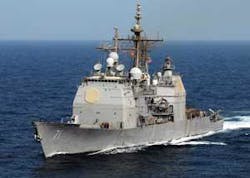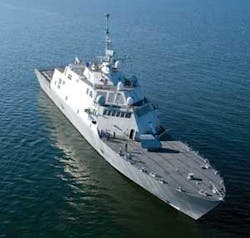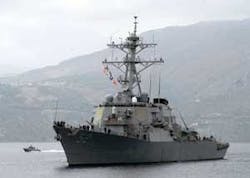Navy steps out on MODERNIZATION
Top Navy leaders are struggling to balance the right kind of ships, the best number of platforms, and the best mix of electronic and electro-optic technologies to meet the changing worldwide threats of the 21st century.
by Edward J. Walsh
In July 2008 U.S. Navy leaders, focused on maintaining congressional support for their service’s shipbuilding program, dramatically reshaped their plan for a new class of Zumwalt-class destroyers (DDG 1000) by slashing the program from seven ships to just two, and restarting production of Arleigh Burke-class Aegis destroyers (DDG 51).
Less than a month later the Navy again revised the plan by adding a third DDG 1000, citing the adverse influence of the cutback on shipbuilders General Dynamics Bath Iron Works in Bath, Me., and Northrop Grumman Shipbuilding in Newport News, Va.–the two companies that build Navy surface combatants.
null
The decision on the DDG 1000 followed months of negotiations among Navy, U.S. Department of Defense (DoD), and congressional leaders. Navy leaders say the DDG 1000 will cost $2.2 billion each, yet other estimates range beyond $3 billion per ship. Originally the Navy wanted to build 24 of the new Zumwalt-class destroyers.
The debate highlighted the difficulty of choosing between two strategies in perennial conflict: the development and integration of new ship technologies with innovative hull and deckhouse structures versus building enough ships to meet operational needs.
Navy leaders acknowledge that it does not make sense to build expensive multi-mission warships like the DDG 1000 and then limit their use to narrowly defined missions. “It is no longer feasible or affordable to purchase the most capable multi-mission platform and then limit its use to execute tailored mission areas or focus on specific threats,” said Vice Adm. Barry McCullough, deputy chief of naval operations for integration of capabilities and resources, and Allison Stiller, deputy assistant Navy secretary for ship programs, in testimony last July before the House Armed Services subcommittee on sea power and expeditionary forces. “The Navy must find affordable and adaptable ways to fill current and future warfighting gaps,” McCullough and Stiller said.
DDG 1000
In August the Navy, DoD, and Congress agreed to build nine Arleigh Burke guided missile destroyers in addition to the 62 originally planned. The Burkes can provide long-range air defense less expensively than the DDG 1000.
“DDG 1000 is a ship that had its genesis in the early 1990s. Our ability to control the seas really calls for us to go in and provide area air defense,” said Adm. Gary Roughead, U.S. chief of naval operations (CNO) in a speech last September. “As I looked at DDG 1000, it did not give us that capability.”
Northrop Grumman and General Dynamics each won contracts in February 2008 to build lead ships of the Zumwalt class. Raytheon’s Integrated Defense Systems in Tewksbury, Mass., is prime contractor and systems integrator for the Zumwalt combat system and other systems.
Roughead, in his 2009 CNO Guidance document, said the Navy is “moving forward to truncate” the DDG 1000 class and continue production of the DDG-51 class to improve our capability and capacity to meet increasing combatant commander demands for integrated air and missile defense.”
In his July testimony, DCNO McCullough pointed out that DDG 1000 is superior to the Burke-class destroyer in close-to-shore anti-submarine warfare, yet he admitted that the new Zumwalt-class ship’s sonar is less effective than that of the Burke-class destroyers in deep water. Unfortunately, the DDG 1000 design sacrifices capacity for increased capability in an area where the Navy already has, and is projected to have, sufficient capacity and capability,” Mccullough told Congress. He added that the DDG 1000 “cannot perform area air-defense, specifically it cannot successfully employ the SM-2, SM-3, or SM-6 [air-defense weapons] and is incapable of conducting ballistic missile defense.” Dan Smith, president of Raytheon Integrated Defense Systems, countered that the DDG 1000 combat system is capable of launching those weapons.
Radars, aperstructures
The Navy in early December not only awarded a $45.8 million contract option to General Dynamics Bath on the DDG 1000 contract, but also awarded a contract modification to Raytheon to integrate several DDG 1000 systems at the Wallops Island, Va., Surface Combat Systems Center and aboard the Navy’s self-defense test ship. The modification covered the SPY-3 multifunction radar (MFR) array, elements of the Mk 57 vertical launch system (VLS), and the DDG 1000 total ship computing environment or TSCE.
In October, Lockheed Martin’s MS2 business unit (formerly Maritime Systems and Sensors) in Moorestown, N.J., announced that it had delivered an engineering development model of the DDG 1000 S-Band volume search radar (VSR) antenna, which will be integrated with the SPY-3 X-Band MFR to form the dual-band radar (DBR) for long-range, wide-area air search, detection, and tracking of missiles and aircraft.
Raytheon is prime for the DBR, which also will be adapted for aircraft carriers. In October, the Navy awarded Raytheon a $23.5 million contract to configure the system for the first of its newest carrier class, the Gerald R. Ford (CVN-78), now under construction.
The company completed a production readiness review for the DBR, Mk 57 VLS, and TSCE. In September, Raytheon completed a critical design review for TSCE software Release 5 of six planned TSCE releases, each of which addresses specific mission capabilities. Release 5, which adds surface and undersea warfare and information operations, brings total TSCE lines of code to 5.9 million. The Navy certified TSCE Release 4 in July.
Lockheed Martin MS2 awarded a $700,000 contract in late December to Parvus Corp. of Salt Lake City to develop a pre-production version of Cisco’s Aironet wireless access point for wireless fidelity (Wi-Fi) network connectivity for DDG 1000.
The DDG 1000 and the LCS are two of three members of the Navy’s future “family of ships” that initially were to use a common combat system design, sensors, and machinery systems. The third ship, called CG(X), eventually will replace the 22 Ticonderoga-class (CG-47) Aegis cruisers for ballistic missile defense and wide-area air defense. The CG(X) also is a candidate for an all-electric integrated power system, and officials say that the Navy has considered a nuclear power plant for the class.
Aegis is not an acronym. It literally means the shield of Zeus, and refers to the front-line air and ballistic missile defense systems aboard Ticonderoga-class cruisers and Arleigh Burke-class destroyers.
The Navy plans to announce the CG(X) design concept in 2009, hoping to build 19 ships. The Navy requested $370 million in FY 2009 for CG(X) research, but the final Pentagon appropriations bill cut that figure by $120 million.
One research initiative aimed at CG(X), sponsored by the Office of Naval Research (ONR), is development of “aperstructures,” short for “aperture structures” that officials in ONR’s Sea Warfare and Weapons Department say “represents a new paradigm for the design and integration of antennas into topside structures,” to address a significant deficiency in the design of the DDG 1000 deckhouse. The effort, under contract to Northrop Grumman’s Electronic Systems and Shipbuilding companies, is designing deckhouse structures that allow sensors to be integrated within them in order to achieve dramatic weight savings.
ONR officials say that the low-radar signature for the DDG 1000 is achieved by installing sensors within the deckhouse, requiring reinforcement of the structure through use of steel stiffeners that support the sensor apertures in “picture-frame” mounts, a design that adds considerable weight.
The aperstructures approach, they say, mounts the aperture in a recessed surface of the deckhouse, eliminating the need to cut a hole, and links the aperture to its control electronics by cabling. The use of aperstructures maintains the structural integrity of the deckhouse without the need for the heavy steel mounting frames.
The Northrop Grumman teams will integrate several antenna concepts in a composite deckhouse, an effort planned for completion in 2011 in time for consideration for CG(X).
Open architecture
The foundation for the family-of-ships acquisition strategy continues to be maximum systems commonality through use of open-architecture commercial off-the-shelf (COTS) software. In August 2004 the Navy established an Open Architecture Enterprise Team, with members drawn from the surface, submarine, aviation, C4I, space, Marine Corps, and anti-submarine warfare communities and the Office of the Chief of Naval Operations (OPNAV) to lead programs aimed at using OA designs for Navy systems. The Program Executive Office for Integrated Warfare Systems, or PEO IWS directs the OAET initiative.
The Navy has established a requirement for a “common objective architecture” for combat system programs, based on such criteria as separation of computer hardware and software and use of commercially developed open standards. Navy and industry managers say that OA now has been incorporated thoroughly in business practices as a reference for use of design methodologies based on industry standards.
The rationale for the objective architecture, Navy and industry officials say, is to “build it once, field it many times” by using common standards for elements of combat systems of surface combatants, carriers, amphibious ships, aircraft, and shore sites.
PEO IWS Rear Adm. Terry Benedict said in November that over the previous 15 months, “the Navy has focused on turning the OA concept into deliverable items.” He said that “when we develop CG(X), we will not build a new combat system–we will build a model that is aligned with how we’re doing the Ohio-class [ballistic missile submarine]. Whatever sits on the platform right now will become the baseline for the new system.”
The Navy also is expanding its SHARE (software, hardware, asset reuse enterprise) repository, which is available to all Navy vendors. Major ship and ship-systems programs have submitted system components to the SHARE network.
The ship systems companies are paying attention. In July, Raytheon announced that it had delivered the first OA-compliant version of the Ship Self-Defense System (SSDS Mk 2) for installation aboard the aircraft carrier USS Nimitz (CVN-68). The SSDS is a Raytheon-developed combat system in service aboard carriers, Wasp (LHD-1), and San Antonio-class (LPD-17) amphibious ships, and next-generation LHAs. The company said that the SSDS Mk 2 for Nimitz also uses a portion of the DDG 1000 TSCE.
Lockheed Martin MS2, prime contractor for the U.S. Coast Guard command-and-control (CG-C2) system for the Coast Guard’s Deepwater program, says that OA compliance for CG-C2 leverages the company’s work on the Aegis combat system for the Ticonderoga cruisers and Burke destroyers.
LCS, cruiser-destroyer modernization
The Navy is focusing on its two front-burner ship programs, the LCS and the Aegis modernization for the Ticonderoga-class cruisers and Burkes, both fitted with variants of the SPY-1 phased array wide–area radar.
The LCSs will be outfitted with separate mission modules for countermine, ASW, and surface warfare (SUW) in shallow-water areas. The lead ship, the 3,000-ton USS Freedom (LCS-1), commissioned in Milwaukee in November, was built to a traditional hull design by Lockheed Martin and Marinette Marine. The second ship, USS Independence (LCS-2), designed as a triple-hulled “trimaran” by General Dynamics Bath and shipbuilder Austal USA, was launched in April 2008 and christened in October. The Independence is going through final outfitting. In 2010, following an operational assessment of both ships, the Navy plans to select one design for the class.
The LCS mission flexibility is based on adapting the ship for countermine, ASW, and surface warfare missions by rapidly loading and offloading the module packages. The modules will consist of new and already-fielded systems that rely on remote guidance for autonomous unmanned operations. Northrop Grumman Systems is under contract as LCS mission package integrator.
The surface-warfare module will incorporate systems for engaging hostile swarming craft, such as electro-optical sensors and 30-millimeter guns, and non-line-of-sight launching systems being developed by Netfires LLC, a joint venture of Lockheed Martin Missile and Fire Control and Raytheon Missile Systems.
For the mine warfare module the Navy will integrate an airborne laser mine detection system from Northrop Grumman, airborne mine neutralization system from Raytheon, the Lockheed Martin WLD-1 remote multi-mission vehicle, which also could have a role in anti-submarine warfare, and an organic air and surface influence sweep, or OASIS, developed by EDO Corp.
These and other systems will be networked for command and control with the LCS and with the MH-60S Seahawk helicopter. The module also will include a rapid airborne mine-clearance system, developed by Northrop Grumman, and Raytheon’s AQS-20A mine-detection sonar.
The ASW module incorporates the vertical takeoff unmanned aerial vehicle (UAV), an unmanned surface vehicle, the advanced deployable system, which provides several networked sonar arrays, and the Sea Talon surveillance system. The systems all are networked to the MH-60R helicopter, which also deploys the Raytheon-developed AQS-22A low-frequency sonar.
The Aegis modernization program for the 22 Ticonderogas and 62 Burkes (eight still to be delivered) started in February 2008 at the BAE Systems San Diego shipyard with hull, mechanical, and electrical upgrades, including fuel and machinery controls, for USS Bunker Hill (CG-52). The primary focus of the effort is enhancing the combat system, built around the SPY-1 Aegis radar. The first seven cruisers, Bunker Hill through Philippine Sea (CG-58), which are equipped with the SPY-1A version, will receive an upgraded combat system computer program designated advanced capability build 08 (ACB08–the number represents the year of fielding).
In May the Navy awarded four sole-source contracts for the combat system modernization to Lockheed Martin MS2. In September Raytheon filed a protest of the decision, arguing that three of sole-source awards were improper and that the Navy should conduct a fully competitive acquisition. In late December the General Accounting Office found the sole-source awards to be reasonable and rejected the Raytheon protest.
Jim Sheridan, director for U.S. Navy Aegis systems for MS2, points out that while the SPY-1A itself is not being replaced, the ACB08 program and new computing infrastructure provide new combat capability, including the ability to launch the Evolved Sea Sparrow air-defense missile, with some modifications to the ship’s Mk 41 VLS. The computer suite for the SPY-1A ships will be enhanced with the Navy-standard UYQ-70 display console powered by IBM Bladeserver processors running Linux.
The CGs also will be fitted with the SPQ-9B surface search radar, which replaces the older SPS-49 and the Phalanx Block 1B close-in weapon system, which adds an anti-surface defense capability.
The modernization for the SPY-1A ships is scheduled for completion in 2011. The work will start in 2012 for the remaining 15 cruisers, Princeton (CG-59) through Port Royal (CG-73), equipped with the SPY-1B radar, and for the Burke DDGs. The SPY-1B CGs and the DDGs will receive an ACB12 computer program.
Burke through Chaffee (DDG-90) use a destroyer variant of the radar, SPY-1D. Pinckney (DDG-91) through DDG-112 receive a SPY-1D(v) “littoral warfare” radar, which is more effective in the intense clutter of close-to-shore littoral environment.
The SPY-1B cruisers and the destroyers will get the Common Display System provided by General Electric, and a Common Processing System, for which the contract has not yet been awarded. Sheridan points out that both the CDS and CPS are capable of running commercially developed software from a range of qualified Navy vendors.
The DDG modernization for Burke through Chaffee also will provide a new multi-mission signal processor and radar transmitter modifications that will provide the full capability of the SPY-1D(v) littoral warfare radar. The Navy is considering requesting funding in the FY 2010 budget to install the new signal processor aboard the SPY-1B cruisers.
The DDGs also will be configured for the Navy’s ballistic missile defense capability, which includes a new SM-6 BMD missile developed by Raytheon Missile Systems, enhancements to the VLS, and introduction of the Naval integrated fire control-counter-air, NIFC-CA, as a component of ACB12. Three SPY-1B cruisers–Shiloh, Lake Erie (CGs-67 and -70), and Port Royal–already are BMD capable, and additional CGs may be upgraded for BMD.
The new ACB08 and ACB12 programs will be replaced with new ACBs every two years. Hardware upgrades are called “technical insertions,” or TIs. A single TI would support two generations of ACBs.
For the Aegis modernization MS2 formed a partnership in 2005 with GoAhead of Bellevue, Wash., a small business and founding member of the Service Availability Forum, an industry consortium that develops commercial standards for many industry applications.
Tyson Moler, aerospace program lead for the company, says that MS2 determined that GoAhead’s middleware product, called Self-Reliant, although developed originally for the telecommunications industry, was both compliant with Navy OA standards and capable of performing Aegis resource management functions. The Self-Reliant middleware has been integrated aboard Bunker Hill via a software interface.
Moler says that GoAhead has developed a new middleware product, SAFfire (SAF stands for Service Availability Forum). MS2 is evaluating SAFfire as a potential replacement for Self-Reliant that would not need the interface.
He adds that the Lockheed Martin-GoAhead relationship supports the Navy’s goal of seeking industrial partners outside defense, while helping the company apply its standards-based products for other defense programs. He adds that the company believes it could support any COTS-based common computing environment.
For the destroyer Aegis modernization, the Navy awarded DRS Technologies a $22.3 million contract in September for design and production of radio station consoles, aiming to automate shipboard damage-control communications. The company says that the RSC consoles, integrated with the ships’ machinery control systems, will communicate via the ships’ Gigabit Ethernet multiplex system network to support damage control applications. The contract calls for up to 20 RSC shipsets and 10 training sets.
Shipbuilding
The Navy continued to push for more ships in 2008 despite a constrained budget. DCNO Adm. McCullough, in his House testimony, spelled out the goal of a 313-ship Navy which he said “represents the maximum acceptable risk in meeting the security demands of the 21st century.”
On September 30 President Bush signed the continuing appropriations bill for FY 2009, providing $12.4 billion for eight new ships: one Virginia-class attack submarine, one DDG 1000, one San Antonio LPD, two LCSs, one joint high-speed vessel (JHSV), and two combat logistics force ships. The bill also provided $200 million to restart the Burke production line.
The fourth San Antonio-class ship Green Bay (LPD-20) built by Northrop Grumman Shipbuilding was commissioned Jan. 24. Lead ship San Antonio and New Orleans (LPD-18) already are in fleet service, and Mesa Verde (LPD-19) has completed its post-shakedown availability.
In April, Northrop Grumman announced that it would delay delivery of the eighth and final Wasp-class big-deck amphibious assault ship, the 40,500-ton Makin Island (LHD-8), until later in 2009 because of quality-control problems that led to construction cost increases.
In December Makin Island conducted builder’s trials in the Gulf of Mexico, proving out the Navy’s first hybrid gas turbine-electric drive propulsion system to go aboard a frontline surface ship. The power plant is built around two General Electric LM2500+ engines and six Fairbanks Morse auxiliary diesel-powered electric motors. The first seven Wasps are powered by conventional GE LM2500 engines, widely in use in the fleet.
In November, the Navy awarded Austal USA a $185 million contract to build a JHSV. The Navy, Army, and Marine Corps have leased four HSVs since 2002 to demonstrate technologies and logistics capabilities.
The four ships–Joint Venture (HSV-1) and Swift (HSV-2), and Spearhead (TSV-1X) built by Incat, and Westpac Express (HSV-476) built by Austal, and operated by the Military Sealift Command–have deployed for operations off Iraq. Swift supported Navy relief operations in Indonesia and in New Orleans after Hurricane Katrina.
The JHSV program results from the consolidation of the Army’s Theater Support Vessel program with the Navy and Marine Corps High Speed Connector (HSC). The Navy aims at construction, with contract options, of up to nine JHSVs to transport Marines, soldiers, vehicles, and equipment in shallow littoral waters for military and humanitarian operations.
Austal USA, the shipbuilder partner of General Dynamics for the LCS Independence, will use General Dynamics Advanced Information Systems as the subcontractor for design, integration, and testing of the OA-compliant computing infrastructure for the new JHSV class, including links for shipboard communications, navigation, weapon systems, and aviation control and coordination.
Ship systems
New shipbuilding and modernization programs led development of new technology for critical systems. In mid-January the Navy announced that it was to release a request for proposals in February for design, development, demonstration, and material for initial production for a Block 2 upgrade to the Surface Electronic Warfare Improvement Program (SEWIP), called SLQ-32X(V). The Block 2 will upgrade the SEWIP receiver, antenna, and combat system interface.
The SEWIP is a series of incremental upgrades to the Navy’s longtime shipboard electronic warfare (EW) system, the SLQ-32. The program began in an attempt to fill a gap in EW capability created when the Navy in April 2002 terminated development by Lockheed Martin of an advanced integrated electronic warfare system for the then-DDX destroyer and other surface combatants.
General Dynamics has acted as the systems integrator for work on SEWIP Block 1 since 2003. The company’s Advanced Information Systems has teamed with BAE Systems for the Block 2 competition with a system called Sea Lightening. BAE Systems tested the system at sea in July 2008. Lockheed Martin MS2 and ITT, which are partners on the Navy’s BLQ-10 submarine EW system, also will compete for SEWIP Block 2, offering their integrated common electronic warfare system, called ICEWS.
The Navy in July and December awarded sole-source contracts to Raytheon Network Centric Systems for production and engineering support for additional units of the cooperative engagement capability (CEC), which Raytheon has built for Navy cruisers, destroyers, carriers, big-deck amphibs, and E-2C Hawkeye surveillance aircraft since the 1990s. CEC integrates air-target data in a common data picture among participants in a CEC network at sea and ashore; the Marine Corps and Army also display CEC data. The Aegis modernization will integrate CEC aboard CGs and DDGs not already equipped with it.
Edward J. Walsh is a longtime Military & Aerospace Electronics correspondent, and is former chief editor of Seapower magazine. He is with the Office of Naval Research.

